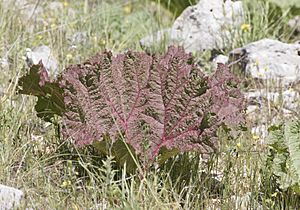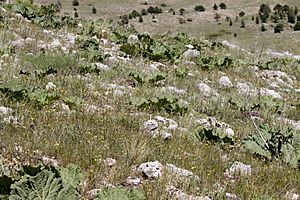Syrian rhubarb facts for kids
Quick facts for kids Syrian rhubarb |
|
|---|---|
 |
|
| Scientific classification | |
| Genus: |
Rheum
|
| Species: |
ribes
|
| Synonyms | |
|
|
Rheum ribes, also known as Syrian rhubarb or currant-fruited rhubarb, is a wild plant that you can eat. It's a type of rhubarb that grows in high mountains, usually between 1,000 and 4,000 meters (about 3,300 to 13,000 feet) high. You can find it on rocky slopes and among stones.
This plant grows in many parts of the world, especially in Western Asia. This includes countries like Turkey, Syria, Lebanon, Iraq, Iran, Azerbaijan, Armenia, Afghanistan, and Pakistan. It also grows in the Ladakh region of India. People in these areas often collect Syrian rhubarb from the wild in early spring to eat. It's also known for its uses in herbal medicine.
Contents
What is Syrian Rhubarb?
The Syrian rhubarb is a strong plant that grows back every year. It can reach up to 1 meter (about 3 feet) tall. It has thick roots called rhizomes that stay alive underground. Each year, new parts grow from these roots.
Plant Parts
- Leaves: It has large, reddish-green leaves that are shaped like beans. These leaves grow on stalks.
- Stems: The plant has edible flower stalks. These stalks are solid and have a bumpy texture. They have leaves near the bottom but are bare higher up.
- Flowers: Its small, yellowish flowers grow in clusters called panicles.
- Fruit: The fruit is dull brown, three-sided, and has broad red wings.
How it's Different
Syrian rhubarb looks a lot like another plant called Rheum palaestinum. You can tell them apart because Syrian rhubarb leaves have five main veins, while R. palaestinum has only three. Syrian rhubarb also grows taller.
It's also similar to Rheum maximowiczii, which grows further north in Central Asia. But Syrian rhubarb has a rougher stem, longer leaf stalks, and a wider flower cluster. R. maximowiczii also has three veins per leaf.
Plant History
The Syrian rhubarb was first officially described in 1753 by a famous scientist named Carl Linnaeus. He wrote about it in his book Species Plantarum.
This plant was first mentioned in Europe in an old Arabic book called the Book of Simple Medicaments. This book was translated into Latin and was popular in Europe from the late 1200s to the 1400s. People learned about a medicine called rob ribes made from this plant.
Later, in 1576, a botanist named Leonhard Rauwolf wrote about it in his book. He was one of the first Europeans to travel through the Middle East and Mesopotamia. He saw the plant growing in Lebanon and Palestine. He said the medicine rob ribes was made from the young flowering stalks.
The name ribes comes from the Arabic word rībās, which means Syrian rhubarb. The word Rheum comes from the Greek word rheon, which was a name for medicinal rhubarb.
Where Syrian Rhubarb Grows
Syrian rhubarb is native to many countries in Western Asia. This includes:
- Syria (including the Golan Heights)
- Azerbaijan (including Nakhichevan)
- Jordan
- Lebanon
- Armenia
- Iraq
- Turkey
- Iran
- Pakistan
- Afghanistan
- Russia
Plant Life and Environment

Where it Lives
This plant is a key part of the plant life in the Irano-Turanian Region, which is a specific plant geography area.
In eastern Turkey, you can find it on dry mountain slopes at heights of 1,600 to 2,600 meters (about 5,200 to 8,500 feet). It often grows with other plants like Prangos ferulacea and Cousinia sivasica. In Israel, it grows on rocky slopes and cliffs in areas where oak forests are found.
Insects and Syrian Rhubarb
Syrian rhubarb is an important food source for certain insects.
- Butterflies: A tiny butterfly called Callophrys mystaphia (also known as the 'rhubarb emerald' in Turkish) mainly eats Rheum ribes. This butterfly was thought to be lost for a long time but was rediscovered in Turkey in 2007-2008. It lives only where Rheum plants grow.
- Moths: The leaves of R. ribes are also food for the moth Xylena exsoleta in Turkey.
- Beetles: Several types of beetles are found with R. ribes in eastern Turkey. These include a type of weevil (Petrocladus sp.), a jewel beetle (Capnodis marquardti), and a leaf beetle (Labidostomis brevipennis). These beetles specialize in eating this plant, and most of them are found only in Turkey. The leaf beetle lays its eggs on the leaves.
Cooking with Syrian Rhubarb
The part of the Syrian rhubarb plant that people eat is its flowering stem. People eat it raw, often in salads. They also cook it in different dishes. For example, in Turkey, they make dishes like ekşili ışgın and ışkınlı yumurta (eggs with wild rhubarb). In Iran, it's used in a dish called khoresh rivas (Persian rhubarb stew).
You can find the flowering stems sold in local markets in places like Northern Balochistan.
Traditional Medicine Uses
Syrian rhubarb is a very important plant in traditional medicine in Western Asia. It's rich in vitamins A, B, and C.
The root of Syrian rhubarb (called Rhizoma Rhei ribi) has been used for a long time to help treat conditions like diabetes, hemorrhoids, ulcers, and diarrhea. In Bitlis, Turkey, people use it to help with digestion and to make them feel hungry.
Traditionally, the dried stem and root of the plant are used to treat anemia, lack of appetite, weakness, anxiety, depression, and diabetes. In Iran, Rheum ribes has been used to help people relax and improve their mood.
Scientists have found special compounds in Syrian rhubarb shoots, such as chrysophanol, parietin, emodin, and various flavonoids like quercetin. These compounds are believed to be responsible for the plant's medicinal properties.
Protecting the Plant
In Israel, Syrian rhubarb is a very rare plant. It's only found in two places in the mountains of the Golan Heights. However, it is not currently protected by law.
Names for Syrian Rhubarb
Old English Names
- rhubarb-currant
- warted-leaved rhubarb
- rhubarb of Babilonia
Local Names
- Arabic: rībās (ريباس) or rāvandu'r-rībāṣ (راوند الريباص)
- Armenian: xanjil haġarǰi (Խանձիլ հաղարջի) or išxun (իշխուն)
- Azerbaijani: qarağat rəvəndi
- Dari (Afghan Persian): čukri (چکری)
- Hebrew: ribes hermoni (ריבס חרמוני)
- Kurdish: ribêz, rêvaz, rêvas, rêwas, rêwaz / ڕێواس
- Persian: rīvās (ريواس)
- Russian: ревень смородинный
- Syriac: yaġmīṣā (ܝܓܡܝܨܐ)
- Turkish: ışgın
- Urdu: rawash
- Zazaki: rıbês
- Pashto: پښۍ
See also
 In Spanish: Ruibarbo sirio para niños
In Spanish: Ruibarbo sirio para niños


